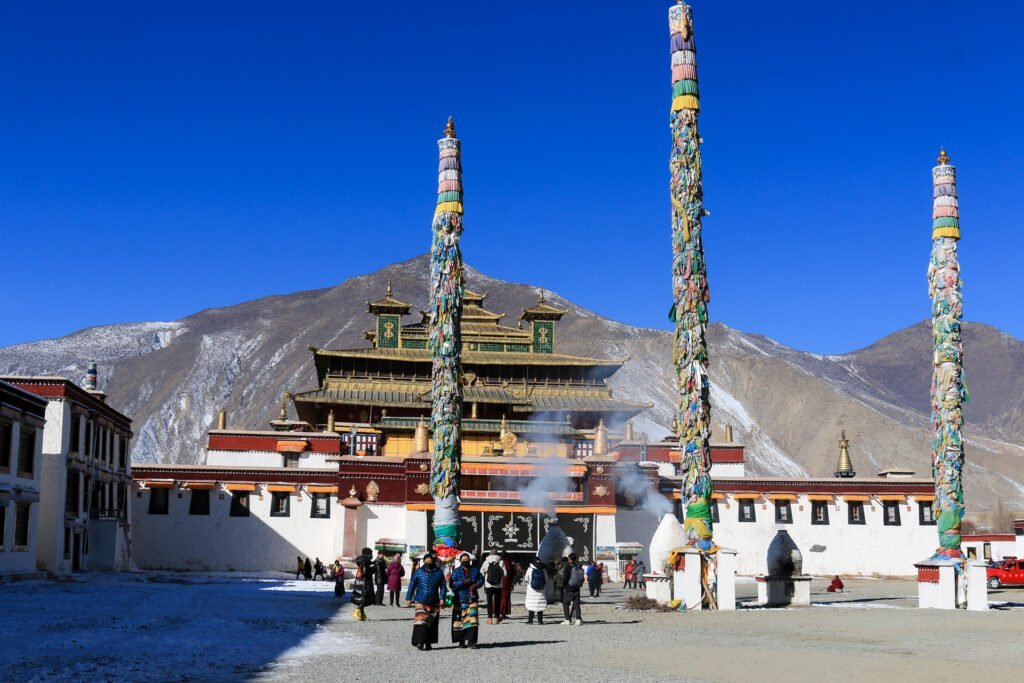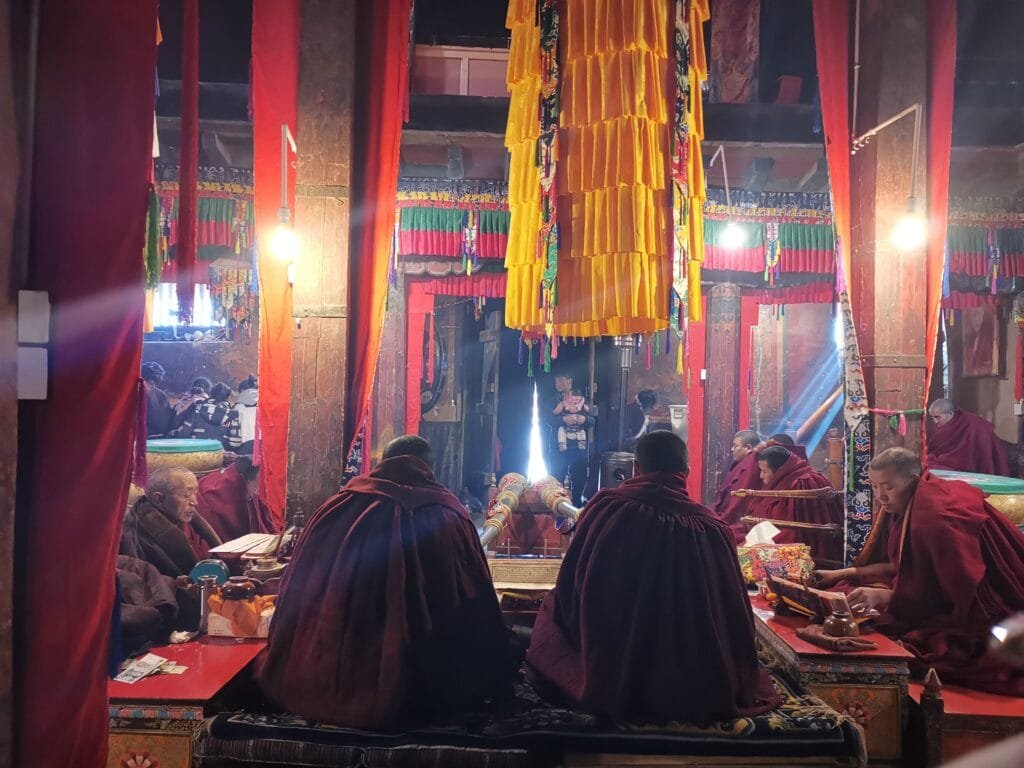In the annals of Tibetan history, few places hold as much religious and cultural significance as the Samye Monastery. Founded in 762 AD by Trisong Detsen, this monastery stands as a testament to the profound spiritual transformation of Tibet into a Buddhist nation. The monastery’s completion in 775 AD marked not just the culmination of an ambitious architectural project, but also the beginning of a new era in Tibetan spirituality.
Tibetan Name: བསམ་ཡས་མི་འགྱུར་ལྷུན་གྱིས་གྲུབ་པའི་གཙུག་ལག་ཁང
The story of Samye Monastery’s origin is as enchanting as its structure. According to the Records of Samye Temple, Trisong Detsen, eager to visualize the future monastery, witnessed a miraculous event: Master Padmasambhava created an illusion of the completed temple from the palm of his hand. Overwhelmed by the sight, Trisong Detsen exclaimed “Samye,” meaning “Beyond the Imagination” in Tibetan, a name that the monastery proudly bears to this day.
The grand consecration ceremony of Samye Temple was a landmark event in Tibetan history. Co-hosted by Shantarakshita and Padmasambhava, it was attended by monks from diverse regions, including the Tang Dynasty, India, and Khotan. This event marked the official adoption of Buddhism in Tibet, establishing Samye Monastery as the first formal monastery in the region to possess the Three Treasures of Buddha, Dharma, and Sangha. This significant moment heralded a new chapter in Tibetan Buddhism, turning Samye into a pivotal centre for Buddhist teachings and practices.



Architecture marvel of Samye Monastery
Architecturally, Samye Monastery is a marvel. Inspired by the Odantapuri Temple in Bihar, India, it represents a harmonious fusion of Chinese, Tibetan, and Indian designs. The “Utse” Great Hall is a prime example of this cultural amalgamation. Before this hall stands a stone stele, erected in honor of Trisong Detsen’s devotion to Buddhism. The monastery also houses a pair of white marble statues, simple in shape yet profound in their Tang Dynasty carving style, ranking among the most precious remaining stone sculptures in the monastery. Additionally, a rare bronze bell, adorned with ancient Tibetan script, holds the distinction of being the first of its kind cast in Tibet.
Over the years, various dynasties have contributed to the expansion of the monastery, which now covers more than 4,900 square meters. Today, Samye Monastery is not just a relic of the past; it is a living embodiment of Tibetan Buddhist culture and heritage. It continues to attract scholars, pilgrims, and tourists, drawn by its rich history, spiritual significance, and architectural grandeur.
In essence, Samye Monastery is more than a mere structure; it is a symbol of the spiritual journey and architectural ingenuity of the Tibetan people. Its enduring legacy continues to fascinate and inspire, serving as a beacon of Buddhist teachings and a testament to Tibet’s rich cultural tapestry.
Samye Monastery: A Cultural and Spiritual Oasis in Tibet
Nestled at the base of Mt. Hepo Ri and cradled by the Yarlung Tsangpo River, Samye Monastery stands as a beacon of peace and spirituality in Zharang County. Situated approximately 38 kilometres from Tsedang, it forms a significant part of the Yarlung River Scenic Area, a state-level scenic site known for its breathtaking natural beauty and rich historical tapestry.
Accessing the Gateway to Spiritual Enlightenment
Reaching Samye Monastery is an adventure in itself. From Lhasa, a three-hour bus journey to the Samye ferry crossing immerses travellers in the scenic splendour of Tibet. The journey costs 27 Yuan and offers a glimpse into the region’s rugged landscape. Alternatively, one can embark from Tsedang, covering around 30 kilometres to the ferry crossing. The final leg of the journey involves a ferry ride across the Yarlung Tsangpo River, costing 360 Yuan, or a unique experience aboard a traditional sheepskin raft. Upon reaching the other side, a modest 3 Yuan truck ride brings visitors to the monastery’s gates.
The Historical Saga of Samye Monastery
Originally known as Samyuan, the name ‘Samye’ is a Tibetan transliteration meaning ‘unimaginable’. The monastery’s inception is rooted in a legendary tale where Indian monk Padmasambhava, upon request from Trisong Detsen to aid in promoting Buddhism, displayed a magical image of the monastery on his palm – a sight truly ‘unimaginable’. This profound moment gave the monastery its name and set the foundation for its future as a centre of Buddhist learning and worship.
Founded in the 8th century by King Trisong Detsen, Samye Monastery faced closure in the mid-9th century when Buddhism was temporarily forbidden in Tobu, the ancient name for Tibet. However, with the resurgence of Buddhism in the late 10th century, it became the central monastery of the Nyingma Sect. The monastery’s significance was further cemented when Trisong Detsen, looking to unify his political power with religious influence, established it as the first formal monastery in Tibet featuring “triratna” – the Buddha, the Dharma, and the Sangha. Samye thus became home to the first group of monks in Tibet, known as the “Seven Jueshi”.
Architectural and Spiritual Grandeur of Samye Monastery
The layout of Samye Monastery, chosen by Padmasambhava and designed by Santarakshita, is a representation of the ideal universe described in Buddhist scriptures. The main hall, “Utse”, symbolizes “Sumeru”, the central world mountain in Buddhist cosmology. Surrounding it, are the Sun and Moon chapels, the four stupas at each corner of the hall, and the additional halls collectively representing celestial bodies, the four Heavenly Kings, continents, and eparchies of the Buddhist universe. Encircling all this is a circular wall symbolizing the mountains at the universe’s edge.
The monastery, covering around 110,000 square meters, is an oasis of tranquillity. Its lush gardens, flowing rivers, and the serene presence of black-necked cranes create a peaceful atmosphere. The main hall, “Utse”, is an architectural masterpiece combining Indian, Chinese, and Tibetan styles, stretching over 4,900 square meters. It features intricately carved and painted posts, stunning murals, and religious artefacts of immense historical value, such as the stone lions guarding the entrance, the Tang Dynasty-style marble statues, and the ancient Tibetan script inscribed bronze bell.
Uce Hall and the Four Pagodas of Samye Temple
Nestled within the serene precincts of Samye Temple in Tibet, Uce Hall stands as a central main hall of great cultural and spiritual significance. It is surrounded by four distinct pagodas, each bearing its unique characteristics, colors, and symbolism. Together, they form a remarkable ensemble that holds both religious and architectural importance.
Symbolism and Significance
The four pagodas that encircle Uce Hall are adorned in white, red, black, and green, with each color carrying profound symbolism:
- White Pagoda: Located in the southeast corner, this pagoda is constructed from stones and slabs and is entirely white. It features 108 small towers on its base and is adorned with intricate stone carvings of sixteen Arhats. Legend has it that this pagoda enshrines relics of the Tathagata and sacred Mani treasures, making it a place of great blessings.
- Red Pagoda: Positioned in the southwest corner, the red pagoda is a unique architectural marvel. Its square but round shape resembles a bell, and it is characterized by ring patterns on its body. This pagoda is a striking earthy red color, adding to its distinctiveness.
- Black Pagoda: Situated in the northwest corner, the black pagoda is another distinctive structure. Its tower body resembles a three-fold bowl with a prominent sword on the brake disc. This pagoda is entirely black, creating a stark contrast with its surroundings.
- Green Pagoda: Found in the northeast corner, the green pagoda boasts a square and polygonal plane. It stands on a high base and features multiple niches with statues. The top of the pagoda holds a Xianglun Pagoda with intricate details. The green glazed bricks used in its construction exhibit exquisite craftsmanship.
Symbolism and Purpose
These four pagodas hold deep symbolic significance within Buddhism. They represent the four heavenly kings, known for their role in suppressing evil gods and demons and preventing natural and man-made disasters. Additionally, they symbolize the four continents in Buddhist cosmology, reflecting the spiritual and universal aspects of the faith.
The Four Pagodas of Samye Temple are not only architectural wonders but also sacred sites that offer a glimpse into the rich cultural and spiritual heritage of Tibet. Their unique shapes, colors, and historical significance make them rare cultural relics that continue to inspire awe and reverence among visitors and pilgrims alike.
Guru Rinpoche’s Demon-Conquering Seal and the Legends of Samye Monastery
At the heart of the sacred Samye Monastery in Tibet lies a remarkable treasure with a rich history – Guru Rinpoche’s Demon-Conquering Seal. This precious seal, revered as a magic weapon, holds a significant place in the spiritual and cultural heritage of Tibet.
The Origins of the Demon-Conquering Seal
According to ancient legends, during the reign of Tibetan King Trisong Detsen, the construction of Samye Temple faced an unusual challenge. The construction work carried out during the day was mysteriously destroyed by demons and ghosts at night, hindering progress. In response to this predicament, Bodhisattva Khenpo, also known as Sadrita Protector, suggested inviting Guru Rinpoche to subdue the malevolent forces.
Guru Rinpoche, also known as Padmasambhava, arrived at the Samye Monastery and successfully subdued the demons. These once-hostile spirits surrendered to Guru Rinpoche and became his devoted Dharma Protectors. They made a solemn vow to protect the Dharma and actively assist in the construction of the Samye Temple.
The Unveiling of the Demon-Conquering Seal
During this pivotal time, Guru Rinpoche retrieved the treasured “Precious Seal for Subduing Demons” from a retreat cave known as “Yelong Xie Zha.” He addressed the protectors, saying, “In the future, anyone who holds or wears this seal must not be harmed, and you should do your utmost to protect them.”
This “Precious Seal of Guru Padmasambhava for Subduing Demons” is now a revered treasure within Samye Monastery. It serves as the primary protector of the monastery, and the guardian deities solemnly pledge to safeguard those who hold it. The seal is believed to provide protection, resolve difficulties, and ward off disasters. It is considered a source of auspiciousness, well-being, and successful spiritual practice.
The Remarkable Statue of Guru Rinpoche
Within Samye Monastery stands a statue of Guru Rinpoche himself. This statue, dating back to the eighth century, is a significant symbol of Padmasambhava’s presence and blessings in Tibet. When Guru Rinpoche saw this statue, he remarked, “Just like me,” and imparted his blessings to it, stating that it was an exact likeness of himself.
Legend has it that this statue possesses extraordinary power. During a smallpox outbreak in Tibet, worshippers prayed to the statue for relief. Miraculously, the statue’s face became covered with smallpox, and the people’s prayers were answered as the smallpox disappeared, averting the disaster.
The Legacy of Guru Rinpoche
The legends surrounding Guru Rinpoche and the treasures of Samye Monastery are a testament to the profound spiritual heritage of Tibet. Padmasambhava’s wisdom and compassion continue to inspire reverence and devotion among practitioners and believers. The Demon-Conquering Seal and the sacred statue of Guru Rinpoche serve as tangible connections to a spiritual lineage that offers blessings, protection, and hope to those who seek them.
A Legacy Etched in Time
Samye Monastery, through its rich history and spiritual significance, stands as a testament to the enduring legacy of Tibetan Buddhism. It’s not just a place of worship but a living museum, encapsulating centuries of religious, cultural, and architectural evolution. For pilgrims, historians, and travellers alike, a visit to Samye Monastery offers a profound glimpse into the heart of Tibetan spirituality and heritage.
